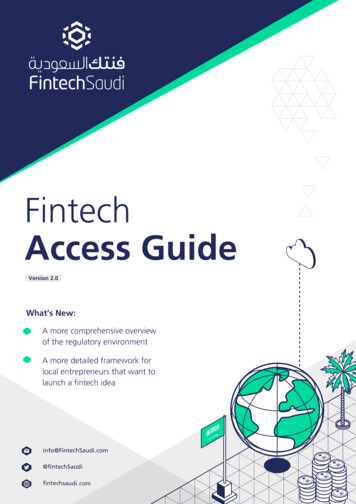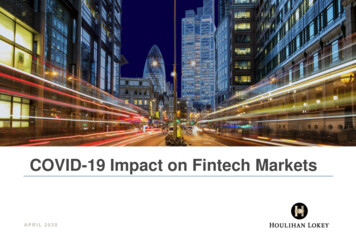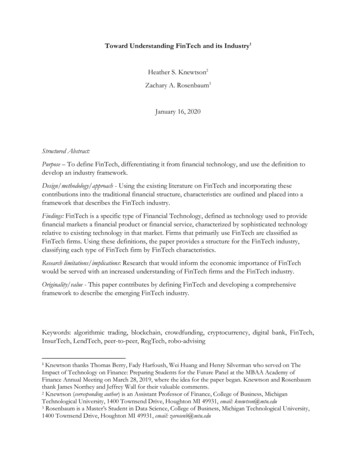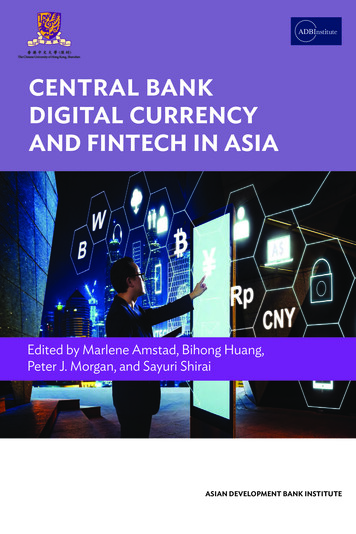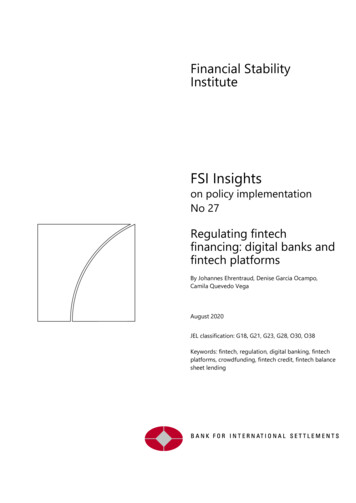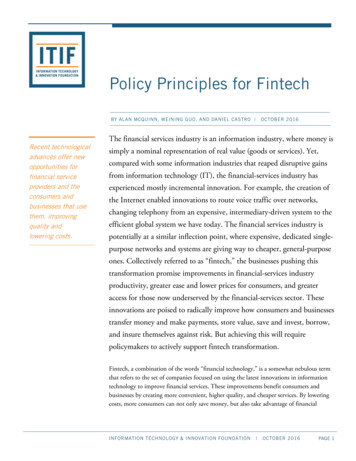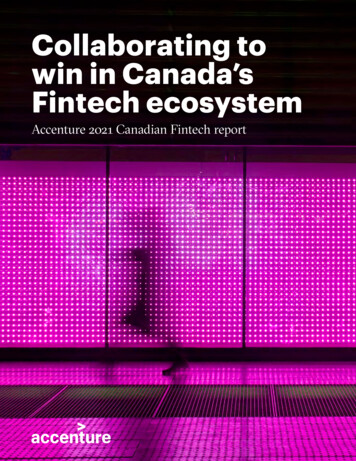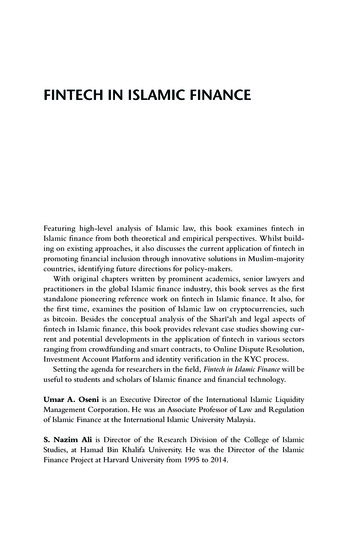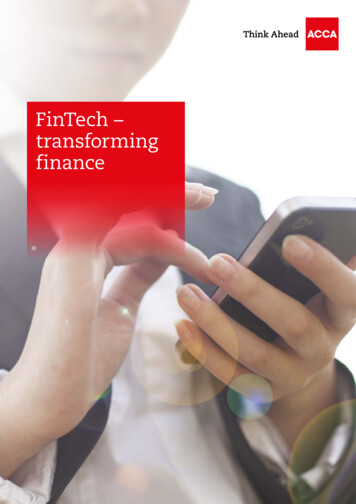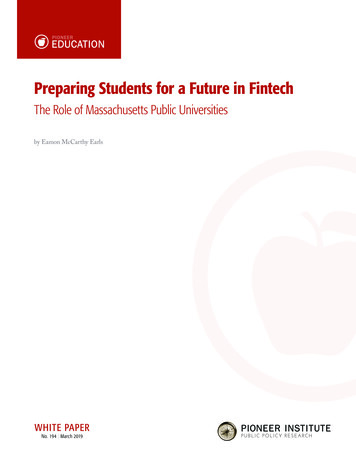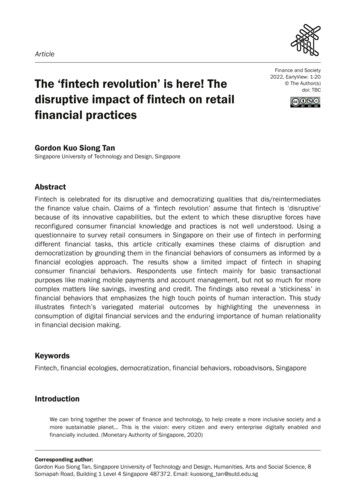
Transcription
ArticleThe ‘fintech revolution’ is here! Thedisruptive impact of fintech on retailfinancial practicesFinance and Society2022, EarlyView: 1-20 The Author(s)doi: TBCGordon Kuo Siong TanSingapore University of Technology and Design, SingaporeAbstractFintech is celebrated for its disruptive and democratizing qualities that dis/reintermediatesthe finance value chain. Claims of a ‘fintech revolution’ assume that fintech is ‘disruptive’because of its innovative capabilities, but the extent to which these disruptive forces havereconfigured consumer financial knowledge and practices is not well understood. Using aquestionnaire to survey retail consumers in Singapore on their use of fintech in performingdifferent financial tasks, this article critically examines these claims of disruption anddemocratization by grounding them in the financial behaviors of consumers as informed by afinancial ecologies approach. The results show a limited impact of fintech in shapingconsumer financial behaviors. Respondents use fintech mainly for basic transactionalpurposes like making mobile payments and account management, but not so much for morecomplex matters like savings, investing and credit. The findings also reveal a ‘stickiness’ infinancial behaviors that emphasizes the high touch points of human interaction. This studyillustrates fintech’s variegated material outcomes by highlighting the unevenness inconsumption of digital financial services and the enduring importance of human relationalityin financial decision making.KeywordsFintech, financial ecologies, democratization, financial behaviors, roboadvisors, SingaporeIntroductionWe can bring together the power of finance and technology, to help create a more inclusive society and amore sustainable planet This is the vision: every citizen and every enterprise digitally enabled andfinancially included. (Monetary Authority of Singapore, 2020)Corresponding author:Gordon Kuo Siong Tan, Singapore University of Technology and Design, Humanities, Arts and Social Science, 8Somapah Road, Building 1 Level 4 Singapore 487372. Email: kuosiong tan@sutd.edu.sg
2Finance and SocietyThe above remarks made by Ravi Menon, the Managing Director of the Monetary Authority ofSingapore (MAS) during the 2020 Singapore Fintech Festival reflect the widely held belief inthe transformative powers of financial technology, or fintech, in bringing about greaterinclusivity and sustainable economic growth. Indeed, frequent claims about the disruptive anddemocratizing powers of fintech are widely circulated in academic, practitioner andpolicymaking circles. Pundits speak of a ‘fintech revolution’ that promises to upend traditionalfinance by revolutionizing the way financial services are delivered and consumed. Forinstance, Long (2018) claims that financial inclusion is making great strides, thanks towidespread mobile telephony and mobile-internet services that have enabled hundreds ofmillions of people to participate in the formal financial system. But these claims are rarelysupported by empirical evidence beyond the handful of success stories that celebrate thepositive qualities of FinTech.With multiple definitions in the literature (Lai and Samers, 2021), this article adoptsSchueffel’s (2016: 45) definition of fintech as “a new financial industry that applies technologyto improve financial activities”. Fintech is often linked to the disintermediation of finance, asperceived through the disruptive tendencies of fintech startup firms in removing traditionalintermediaries like banks from the financial value chain. There is a rich interdisciplinaryliterature on fintech that is mainly located in business and information systems studies.Research from the business literature has emphasized the importance of user behaviors,exploring this theme as specific behaviors within a particular fintech service or as the driversof adoption of a fintech product. For instance, it was found that in lending-basedcrowdfunding, colocation is important because lenders tend to support borrowers who areculturally and geographically more proximate (Burtch et al., 2014). Elsewhere, two recentarticles (Lai and Samers, 2021; Wójcik, 2021) have revealed a modest but growing body ofwork coming from geographers that draws out the spatialities of fintech.This article acknowledges studies highlighting the critical role of fintech in enablinggreater financial inclusion in the Global South, with the notable example of mobile financialservices in Africa (e.g., M-Pesa in Kenya), which have illuminated the transformational qualitiesof fintech in leapfrogging traditional financial institutions and shaping consumer financialpractices that are digitally mediated. However, it also notes that financial inclusion hasbecome a fuzzy concept given the multitude of actors and interventions involved, where theterm assumes various forms and meanings in different places and contexts, depending onaccess to a wider range of financial services, usage of those services, and the terms on whichthose services are being provided and used (Kirwan, 2021). Fintech has become closelyaligned with the ambitious policy goal of financial inclusion due to its involvement with newmobile technologies in facilitating access to formal financial services for a new class offinancial consumers (Gabor and Brooks, 2017). Critical studies on this fintech-led agenda offinancial inclusion have portrayed this project as an extension of the broader patterns of the‘financialization of daily life’ (Bernards, 2019). These studies have provided valuable critiqueof how digital technologies facilitate the capturing of data from traditionally marginalizedconsumers that feed into the behavioral change and risk management strategies of lenders(Gabor and Brooks, 2017), using novel methods of credit scoring to make those consumers‘legible’ to credit markets (Aitken, 2017).However, these accounts fail to consider the uneven progress and limited character offinancial inclusion and fintech applications in practice (Bernards, 2019). While currentresearch, especially from development studies, is mostly focused on developing economieswith substantial unbanked populations, financial inclusion is less understood in the context ofdeveloped countries. As noted by Kirwan (2021), in the Global South, financial inclusion
Tan3focuses on changing the conditions of access and usage to financial services, whereas similarinterventions in the Global North emphasize changing the financial subject, with knowledgegaps more so than access issues driving financial education programs for marginalizedpopulations. This difference speaks to dimensions of financial inclusion that are not easilyquantified, namely the quality of service and compatibility with customers’ needs, and thequalitative use of such services by different consumer groups (Koh et al., 2018), which areless discussed in current studies on financial inclusion in the developed world.It is assumed that fintech is inherently disruptive because of its innovative tendenciesthat allow it to reconfigure the organization of traditional financial systems. Fintech innovationis derived from three aspects, namely the technological innovations by highly entrepreneurialstartups backed by venture capital, the design of new products and services that meet theunserved or underserved needs of consumer segments that are often neglected bymainstream finance and operating new business models that rely on digital platforms toreintermediate the financial value chain (Gomber et al., 2018). The emphasis on the internetand mobile technology in fintech has expanded access for a widened customer base beyondtypical bank branches and other financial firms, where big data analytics can provideinnovative ways of assessing credit worthiness (Aitken, 2017) and offer more personalizedfinancial recommendations. However, the extent to which these disruptive forces havereconfigured financial knowledge and practices has not been sufficiently examined in thewake of the fintech boom, and in a way that critically analyzes the democratizing, disruptive,and alternative characteristics of fintech (Langley and Leyshon, 2017a). The Covid-19pandemic has given a further boost to fintech as more countries and smart cities movetowards the digitalization of finance, which are by and large characterized by a narrowpreference for contactless payments and mobile banking. This is reflected in repeatedreminders by authorities for citizens to transition to mobile banking and payments to reducevirus transmission risks. The capacity for fintech to disrupt the financial system is reinforcedby the so-called ‘cultural circuit of capital’ led by management consultancies and think tanksthat aim to influence corporate and public policy decision making (Leyshon, 2020).Fintech’s disruptive qualities are projected onto individual consumers and businessesalike. For the former, idealized tropes of the digitally savvy user who enthusiastically embracesall forms of fintech solutions are often employed in encouraging adoption of fintech productsand solutions. Retail consumers are portrayed as passive users who are willing and ready totake advantage of the convenience and efficiency afforded by fintech solutions (PwC, 2019).However, how has fintech changed the current ways of performing general financial tasks, likesaving, borrowing, and investing in the context of countries that already enjoy a well-developedfinancial system? Is financial inclusion necessarily a problem for consumers who are alreadywell-served by the existing financial system? This article explores these two questions byexploring pluralistic consumer financial practices through user surveys. Doing so provides aricher understanding of human agency in the context of fintech rather than just framingadoption via the dichotomy of either an embrace of or resistance to digital technology. Thisarticle challenges this dichotomous interpretation by highlighting the agency of users indetermining their articulation into fintech spaces. To the extent that fintech represents thenext frontier in the financialization of users, this article shows how users can ‘resist’ theadoption of fintech by preferring to stick to analog modes of financial behavior instead ofadopting digital solutions.This article contributes by foregrounding fintech in everyday consumer financial behaviorsand critically examining the disruptive and democratizing qualities of fintech and theassociated idea of financial inclusion. It explores consumer financial practices in five key areas
4Finance and Society(paying, saving, borrowing, risk management, and financial advice) by gauging the nature ofthe disruptive impact of fintech on retail finance consumers. Using a questionnaire conductedwith financial consumers in Singapore, this study provides a snapshot of the prevalence offintech adoption among the population in the performance of various financial tasks, such asmaking payments and investing money. Thus, the disruptive qualities of fintech areinterrogated in the context of user behaviors by examining how fintech has changed howconsumers transact. Specifically, how and to what extent has fintech transformed and shapedconsumer financial practices? In doing so, this study reframes financial disruption not from abusiness perspective in terms of the impact on banks, financial institutions, and technologycompanies (Langley and Leyshon, 2017b), but from a consumer-behavioral perspective that iscurrently lacking in academic studies on fintech. Investigating how consumers engage withvarious applications of fintech would help in furthering our understanding of how theincreasing digitalization of finance produces new financial subjects and subjectivities. Further,unpacking the attendant issues of power and agency in shaping the terms under which suchconsumer engagements occur can help break down the current conceptualization of fintech asa monolithic industry-led entity by interrogating the popular discourse surrounding theapparent transformative qualities of fintech.The remainder of the article proceeds as follows. First, the concept of financial ecologiesis elaborated to demonstrate its utility in understanding diverse monetary and financialsystems. A discussion of innovation then follows to outline the disruptive qualities of fintech inthe context of Singapore. After explaining the methodology, the questionnaire results arepresented to evaluate the state of fintech adoption in Singapore. The impacts of fintech oncurrent and future financial behaviors are investigated, guided by the financial ecologiesframework that focuses on tracing the relational shifts between consumers and financial firmsthat give rise to changes in financial practices. The results are then linked back to a discussionof the disruptive and democratizing qualities of fintech and a more nuanced interpretation offinancial inclusion. The last section concludes.Financial ecologiesWhile ecosystems seem to be the more popular metaphorical description for fintech in boththe scholarly and grey literature (Leyshon, 2020), this article uses the ecologies concept asthe preferred term. Financial ecologies recast the financial system as a “coalition of smallerconstitutive ecologies, such that distinctive groupings of financial knowledge and practicesemerge in different places with uneven connectivity and material outcomes” (Lai, 2016: 28).The financial ecologies concept was originally developed to address the geographies offinancial exclusion (Leyshon et al., 2004), in which some individuals enjoy privileged access tomainstream financial services while others are either excluded or partially connected to thefinancial system. Shaped by knowledge and trust, Leyshon et al. (2006) show the emergenceof two distinct ecologies in the UK retail financial services. The first is a prime group ofcustomers who are well-connected to mainstream finance, while the second consists ofsubprime consumers who are serviced by alternative financial providers that rely on ‘relic’practices including door-to-door lending. The rapid digitalization of financial services suggeststhat the same exclusionary dynamics may arise despite claims that digital finance is fosteringgreater inclusion. Varying levels of competencies in handling digital technologies (e.g., internetbanking) and different financial practices that are culturally mediated result in heterogeneityin the way retail financial services are organized and in how the relationships amonginstitutions, markets, and economic actors evolve over space. In short, some places are better
Tan5connected to the financial system network than others. This variegated nature of interactionswith the financial system produces distinctive types of financial ecologies that are made up ofdifferent financial knowledge and practices (Leyshon, 2020: 129).Economic geographers have applied the ecologies concept to unpack the relationshipsbetween space, institutions, and the socioeconomic conditions of financial subjects underdifferent contexts that range from the financialization of urban infrastructure (Grafe and Mieg,2019) to wealth management for financial elites (Beaverstock et al., 2013) and retail financialadvising practices (Lai, 2016). Financial ecologies offer a useful concept for thinking about theheterogeneity of fintech practices as they unfold across space and time. Langley and Leyshon(2017a) identify five distinct ecologies in crowdfunding that are driven by various motivations,such as fandom and affect. With fixed income and P2P lending aligning closely with financiallogics via credit-debt relations, they show the variegated and uneven nature of fintech.Ecologies emphasize the relational processes that occur in the coming together of differentplayers, institutions, financial knowledge, technologies in distinct combinations. Theserelational processes have different topologies as conditioned by proximity and connectivity,giving rise to unevenness in terms of sociospatial inclusion and exclusion, and its attendantinequalities (Langley and Leyshon, 2017a: 1021). A financial ecologies perspective is focusedon capturing the emergent and fluid nature of sociospatial relations as they unfold in theevolving roles and structures of institutions, markets and actors, making it appropriate as ananalytical tool to examine the nascent fintech sector (Lai, 2020). As noted by Lai (2020: 447),an ecologies framing of FinTech can aid in highlighting the ‘stickiness’ of particular relationsand processes that are more resistant to change than others, allowing for a closer examinationof the power relations between the incumbents (mainstream finance) and disruptors (fintech).Disrupting finance with fintech: The Singapore experienceDisruptive innovation, as coined by Christensen et al. (2015) to guide companies in innovationdriven growth, refers to the process whereby a smaller firm with fewer resources cansuccessfully challenge more well-established incumbents by tailoring products and servicesthat meet the demands of overlooked customer segments. In what seems to be a widespreadmisunderstanding and misapplication of the core ideas of disruptive innovation (Christensenet al., 2015), this article implicitly acknowledges the overly liberal use of the term byacademics, policymakers, and practitioners to describe almost any industry shake-up wheresmaller players undercut the incumbents’ existing business models. Fintech has becomesynonymous with the disruption of traditional financial markets. Since the 2008 GreatFinancial Crisis that led to the adjustment of post-crisis regulatory frameworks, innovation isno longer the sole remit of banks and other established financial institutions, leading to theemergence of a new breed of start-ups from both the finance and technology sectors thatpromise to ‘revolutionize’ finance. This was echoed in a PwC (2016) report, which proclaimedthat “the accelerating pace of technological change is the most creative force—and also, themost destructive one—in the financial services ecosystem today” and that “fintech will drivethe new business model”.Singapore is ranked as a top fintech hub together with other prominent internationalfinancial centres, such as London and New York (Findexable, 2019). This has validated thestate’s strategy of innovation-driven growth, in which fintech plays an important role inbolstering its capabilities and status as a ‘smart’ financial center. With regulatory innovationssuch as sandboxing (consumer trials of new fintech solutions) and a pro-businessenvironment, a vibrant fintech industry has emerged in Singapore over the past five years that
6Finance and Societycontinues to experience dramatic growth. The city-state has been aggressive in attractingfintech startups to promote wider innovation in the finance sector. Fintech firms, particularlythe small and agile start-ups, are disrupting the finance landscape with innovative productofferings, new business models, and the responsive deployment of innovative technologies,where they can offer new products and services that meet the specific needs of underservedor unserved customers (Gomber et al., 2017). Between 2015 and 2020, the number of fintechfirms has mushroomed from less than 100 to more than 1000, and industry fintechinvestment has increased steadily from US 299 million to US 861 million (Wyman, 2020).This is supported by continuous infrastructural developments that enhance the nationalunified electronic payments network. In 2014, the Fast and Secure Transfers (FAST) systemwas implemented to facilitate direct instant interbank payments between individuals andbusinesses. This was followed by the PayNow system in 2017 that enabled real-time peer-topeer transfers using a mobile or personal identification number. A national digital identitysystem (SingPass) was integrated into the national payments infrastructure to streamlineaccount creation procedures, while the Singapore Quick Response (SGQR) code was launchedin 2018 to enable retailers to display just one single QR code that connects to multiple epayment providers.In framing its appeal to users, fintech is often described as disrupting traditional financeby using platforms to provide greater convenience, lower costs, higher service quality andefficiency, and customized products and services to different market segments (Lai andSamers, 2021). These affordances have shaped financial practices of consumers. Forinstance, the invention of portable card reader devices has allowed merchants and consumersto send and receive payments on the go using their mobile smartphones and tablets, insteadof being tethered to physical payment terminals. Similarly, in financial advising, onlineinvesting platforms, such as roboadvisors like Syfe and StashAway now offer customizedportfolios that are tailored to individual investors’ financial circumstances thereby replacingthe need for physical meetings with human financial planners. Individuals can now easilypurchase customized insurance products that are underwritten by data analytics technologies,which charge lower premiums and provide better customer service using automation than theestablished insurance companies. More importantly, these digital platforms have changedconsumer behavior and reshaped financial practices by reducing the need to transact throughhuman agents. These numerous examples support claims of the disruption anddemocratization of finance, themes that are frequently incorporated into official publicnarratives that speak of improving consumer financial practices through innovation andtechnology (see e.g., Monetary Authority of Singapore, 2020).MethodologyThis study is part of a wider research project that explores the impact of the digitalization offinance on Singapore consumers. An online questionnaire was sent in March 2021 with thehelp of a market research firm (Dynata). The sample obtained was representative of thedemographic distribution of Singapore’s general adult (21 years and above) population asdelineated by age, race, and gender. The study author supervised the review on questionnairedesign, survey programming, dissemination and data processing using Dynata’s in-housesurvey platform. The questionnaire aimed to survey respondents on their self-reported use oftraditional and fintech-based financial products and solutions.The Covid-19 pandemic was used as a reference point to determine whether theirfinancial behaviors changed in terms of greater adoption of fintech services,as social
Tan7distancing and other public health measures accelerated the digitalization of retail finance. Italso allows to gauge expected consumer behaviors by comparing two distinct time windows –one during the pandemic and the other after the pandemic. Besides surveying respondentsabout their ownership of both traditional financial products, such as bank accounts, andfintech products, such as mobile payment wallets, the questionnaire also asked informantsabout the motivations behind using fintech. One questionnaire section was dedicated tosurveying respondents’ attitudes towards the use of human agents and/or automatedinvesting services, i.e., roboadvisors, to determine how fintech has shaped consumer financialpractices with regards to financial planning and investing. A total of 613 responses werecollected from a sample size of 1000, indicating a response rate of about 61%. Table 1provides a summary of the demographic profile of the respondents.Table 1. Profile of respondents.Ecologies of fintech adoption in SingaporeThe respondents are well integrated into the mainstream financial system in terms oftraditional (non-fintech) financial product ownership. A very high proportion of them are
8Finance and Societybanked (95.4% have a bank account) and 71.5% have private insurance plans. About half(48.6%) have an investing account and 71.3% own a credit card. The results mirror those fromrecent surveys of financial inclusion, such as the Global Findex database (2017 edition), whichindicate that about 98% of Singapore consumers have a financial institution account(Demirgüç-Kunt et al., 2018). However, only about 56% have a fintech account. Among them,35% have only one account, 30% have two accounts, and 7% have more than five accounts.Given the plethora of fintech options in the market, the adoption rate is lower than expectedconsidering the government’s big push towards digital finance.The use of fintech by consumers in Singapore is motivated by the practical benefits thatrevolve around convenience and efficiency, cost savings, and improved user experiences. Thetop three reasons for choosing a fintech product over a traditional financial offering are (i) timesavings (77%), (ii) money (cost) savings (37%) and (iii) better service (36%). Figure 1 shows theusage of different solutions among fintech users. Most users (70%) use fintech for digitalpayments. This is likely driven by the well-developed payments infrastructure, as reflected inthe wide acceptance of digital payments on various platforms as well as strong support forelectronic payment modes by local banks who partner with technology firms that link locallyissued bank cards with payment platforms like Apple and Google Pay. The PayNow and FASTsystems also increase consumer familiarity with digital payments by facilitating the electronicexchange of funds between different parties.Figure 1. Adoption of various products and services among respondents who identify as fintech users.As a nation where buying insurance is a prevalent practice (72% of respondents haveinsurance plans), fintech-based insurance adoption remains rather low with only 20% havingused fintech to buy insurance. This may be explained by the current practice of buyinginsurance in Singapore. Clients typically consult with a financial advisor (Lai, 2016;MoneySense, 2018) who can make suitable product recommendations after analyzing the
Tan9client’s individual financial needs. This value-added service may result in a weaker inclinationtowards purchasing insurance through fintech, where information-seeking (such as comparinginsurance plans) and decision-making processes rest solely on the consumer.An interesting observation is that fintech adoption is stratified by age group, educationlevel, and monthly household income (figure 2). Such differences were not observed forgender, where about half of respondents reported having a fintech account. This resultsuggests that fintech can help to bridge the financial inclusion gender gap that persists evenin developed economies (United Nations Conference on Trade and Development [UNCTAD],2021). The proportion of respondents who have a fintech account within each age grouppeaks at 25-34 years and then steadily declines. This is consistent with the generalobservation that technology use declines with age, where older consumers prefer to usetraditional methods of making financial transactions compared to younger consumers who aremore open towards new technologies. Another possible explanation is that the financial needsof older consumers are already well-served by traditional financial channels, such as buyinginsurance plans through their financial advisors when they were younger. Even after explainingthe fintech concept using various local examples in the questionnaire, 8% of respondentsremained unsure about whether they had a fintech account, which suggests a limitedawareness of fintech amongst the general population.Figure 2. Fintech account ownership by age, education level, and household incomeWhen the proportion of respondents who have a fintech account is broken down byeducation level, a clear pattern emerges whereby the adoption rate increases with educationlevel, with those having a university degree and above reporting the highest adoption rate.Given the novel nature of fintech and its ongoing development, it is more likely that those whoare more well-educated would be able to understand how fintech solutions work and thereforebe more willing to use them. Those with lower education levels may be more uncertain as to
10Finance and Societywhether they even have a fintech account. A similar trend was observed with householdincome where the proportion of those with a fintech account rises with income, falling only atthe highest income bracket. Consumers from more affluent households may be more familiarwith fintech as their financial needs become more complex, such as having more disposableincome to save and invest, where they perceive more clearly the benefits of integrating fintechsolutions in wealth management.Overall, the analysis shows that the adoption of fintech among differentsociodemographic groups is uneven, with the elderly, less educated, and lower income groupsbeing less-active users of fintech. The findings thus point to the limits of fintech in fosteringeven greater financial inclusion by using technological affordances to democratize access tofinancial services in societies, which already enjoy wide access to and are well-served bymainstream finance providers. Rather than thinking of fintech as a financial inclusion tool thatpromotes access to financial services for everyone, this uneven adoption of fintech can bereinterpreted to indicate the possibility for different ecologies to emerge that serve specificconsumer groups, some of whom prefer the intimacies of face-to-face meetings. For example,the drop in fintech usage at the highest income bracket may reflect a preference for nonfintech-based services. The complex financial needs of extremely wealthy individuals areaddressed by dedicated teams who provide specialized services and independent adviceunder exclusive private wealth management ecologies (Beaverstock et al., 2013) that aretypically out of the reach of ordinary retail consumers.‘Disrupting’ financial behaviors with fintechRespondents were asked about changes to their
democratization by grounding them in the financial behaviors of consumers as informed by a financial ecologies approach. The results show a limited impact of fintech in shaping consumer financial behaviors. Respondents use fintech mainly for basic transactional purposes like making mobile payments and account management, but not so much for more


